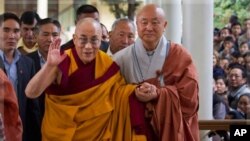One of the key demands Tibetan self-immolation protesters have been calling for as they set themselves on fire is for China to allow the Dalai Lama to return to Tibet. Some Tibet analysts say Beijing is missing a crucial opportunity by not engaging the Dalai Lama to find a compromise to the situation. But, from China’s perspective, increasingly so, it is Tibet’s exiled spiritual leader that is the problem, not the solution.
It is no secret that China distrusts the Dalai Lama. He is routinely blamed as being the source of unrest in Tibetan parts of China and is the frequent target of scathing attacks in China’s state media and in Internet chat rooms.
Late last week, the state-run Chinese website China Tibet Online carried a commentary that not only accused the religious leader of instigating the self-immolations, but of advocating what it said was “Nazi-style” racial segregation. The official Xinhua news agency also published the commentary.
View an interactive timeline of the Tibetan self-immolations from Radio Free Asia
Tibet specialists in China say that while those who self-immolate may be calling out for the exiled spiritual leader’s return, the Dalai Lama’s influence is waning in Tibetan parts of the country. Chinese authorities have branded the acts as terrorism and say those who have participated in the flaming protests are largely individuals who are social outcasts and criminals.
Tanzen Lhundup, with the China Tibetology Research Center in Beijing, said “When talking about a historical solution, we should first note that the Dalai Lama chose to flee to India in 1959, no one sent him to India. It is not the central government that sent him there. He chose to go there himself. And now, over 50 years have passed. Tibet has become a historical issue.”
He added, “We note that the people who set themselves alight make the request that the Dalai Lama come back form India to China. The fact is that the central government has never stopped him from coming back. We have all along hoped that he would come back, but he chose not to.”
Chinese academics also argue that the Tibet of today, is not the same place the Dalai Lama left over five decades ago. Instead, they say, it is a place in transition.
However, what Tibetan parts of China are transitioning to is unclear.
Some Western Tibet experts believe that time is running out for any type of negotiations between the Dalai Lama and Chinese authorities. Tibet's exiled spiritual leader is getting older and the last time representatives from the two sides met, was in 2008.
Robert Barnett, a Tibet specialist at Columbia University, said, “At the same time the Tibet issue inside Tibet is shifting very fast from an issue that is about discontent with the Chinese government … to a real desperation, a real sense among many Tibetans that China cannot be trusted at all, that there is no way you can make a deal with China.”
The Dalai Lama says that what he is seeking is greater autonomy for the Tibetan people in China and guarantees that their identity, language, religion, and culture be preserved. But China believes the Dalai Lama’s ultimate goal is independence for Tibet.
Thupten Jinpa is the Dalai Lama’s English translator. He says that while the Dalai Lama has formally stated that Tibetans are willing to let go of their demand for independence and seek some kind of accommodation within the larger family of the People’s Republic of China, Beijing appears to lack the political will to reach any kind of a solution. “From a cynical point of view, one could say that their strategy may be to simply wait out the present Dalai Lama, and their calculation is that once he’s gone, then there will be no energy left in the freedom movement, the international community will no longer pay any attention and then gradually the issue will disappear. But I think this is quite a big gamble," he said.
He says Tibetans are seeking something similar to what China has set up in Hong Kong. “Culturally speaking, Hong Kong people are much closer to mainland China, but because of its history and economic importance, China has been able to create a particular model of governance at the local level in Hong Kong. From the Tibetan perspective, when we look at this, we know that the Chinese can do this, but at the same time, when it comes to Tibet, they seem to be completely paralyzed," he said.
Yet, while China’s leaders may appear paralyzed when it comes to Tibet’s exiled spiritual leader, they have recently expressed some sympathy for the protestors - albeit while condemning their actions.
And one possible sign that China may be trying to get a different perspective on the situation came in a recent report published in the state-run Global Times newspaper. According to the report, Chinese authorities recently dispatched more than 20,000 officials to visit some 5,000 plus villages in Tibet. The purpose of the visits, the report says, was for officials from government bodies and institutes to live and eat with villagers, understand their demands and help them solve their problems promptly.









